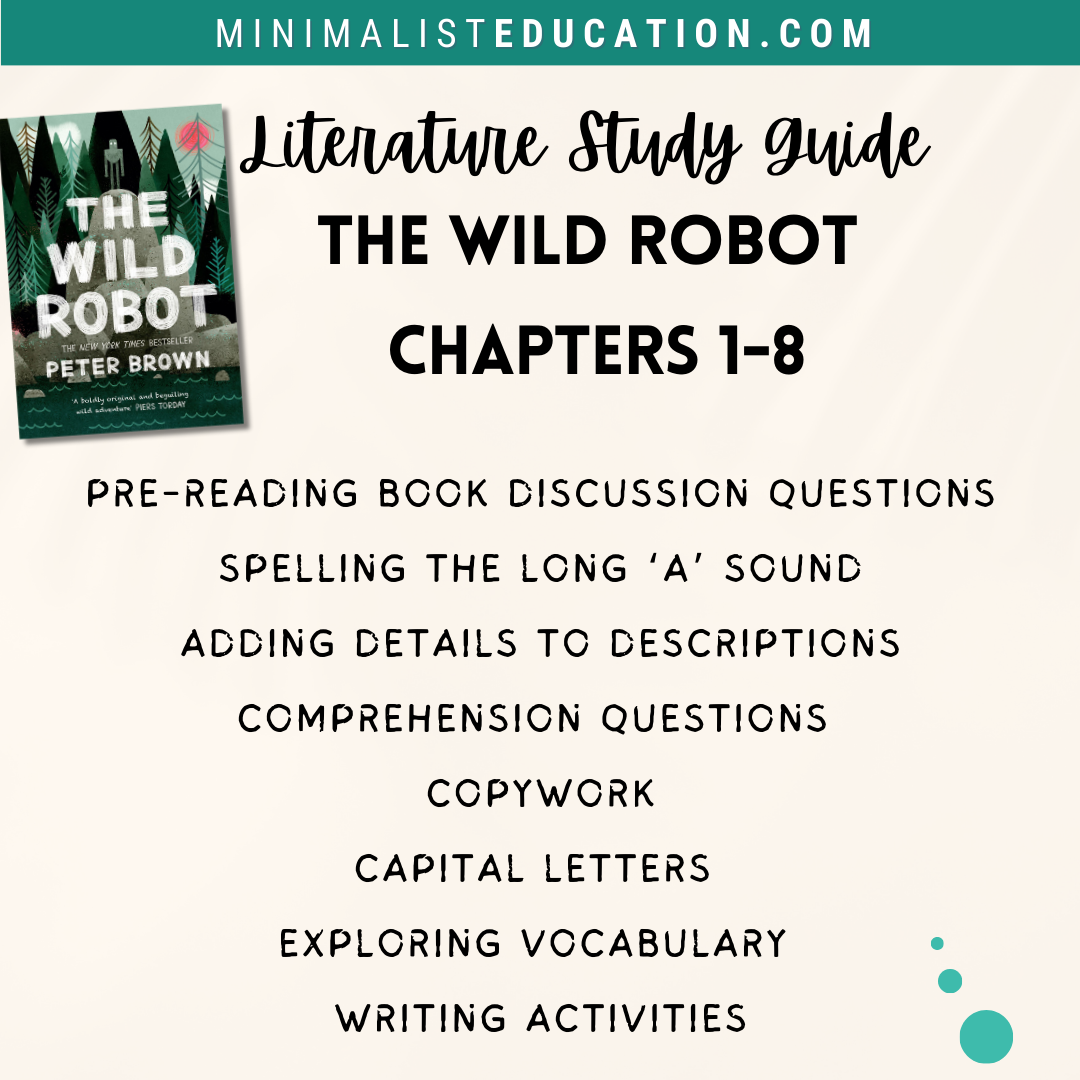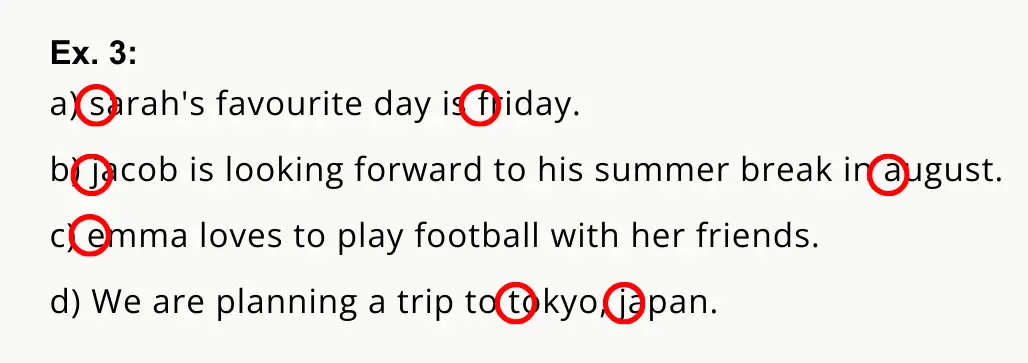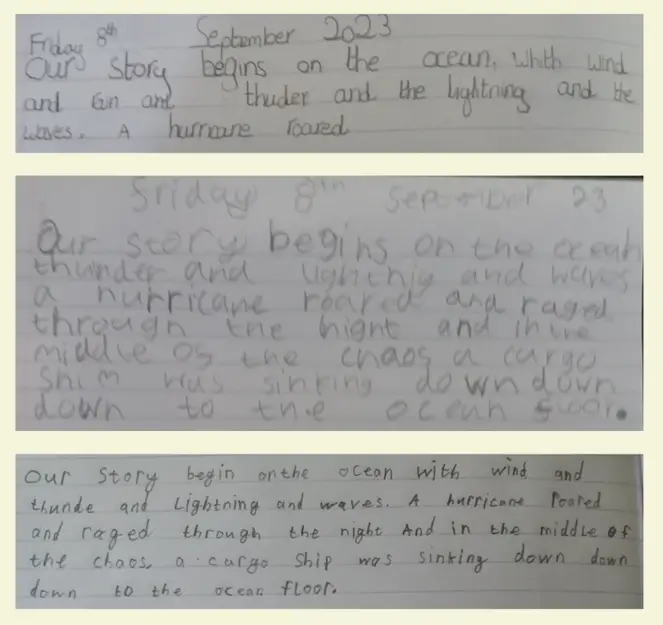Capital Letters and Adding Details to Descriptions: The Wild Robot Chapters 1-8 Study Guide
This post contains affiliate links. I may get a commission if you decide to make a purchase through my links, at no extra cost to you.

Pre-reading book discussion questions, comprehension questions, adding details to descriptions, when to use capital letters, exploring vocabulary using the Freyer Model, short writing activities, and spelling the long ‘a’ sound. This is what you can expect in this weeks The Wild Robot literature study guide based on Chapters 1-8.
Looking for more information on this literature guide?
If you’re just joining us or would like more background on why I created this guide and how to use it effectively, please visit The Wild Robot Literature Study Guide: Introduction. There you’ll find:
- Why I chose The Wild Robot for Year 3/4 readers
- Tips on using the study guide flexibly in your homeschool
- Guidance on adapting the activities to suit your child’s needs
- Links to all weeks of this literature study series
Just starting The Wild Robot journey?
This guide covers Chapters 1-8. For the complete introduction to the series and links to all weekly guides, head over to our Wild Robot Literature Study Guide Introduction.
Welcome to the first of a series of posts that will take your kids on an extraordinary literary adventure.
In this post:
- The Wild Robot teaching notes and answers for Chapters 1-8.
- Examples of children’s work.
- Download The Wild Robot Study Guide for Chapters 1-8.
Get your copy of The Wild Robot (paid link)
The Wild Robot Teaching Notes
Before You start Reading:
In my post 5 Ways to Teach Comprehension I touch on why pre-reading questions are great for engaging kids.
Pre-reading questions give children a chance to recall and activate their excising knowledge. Discussing the book also helps create a context for children to link what they read to.
- Ex. 1 Discuss the aspects of the book cover and blurb using the pre-discussion questions.
Read Chapters 1-3:
- Ex. 2 Answer the comprehension questions. These can be discussed first before writing.

- Read the extract and discuss the notes given about this extract.
“Our story begins on the ocean, with wind and rain and thunder and lightning and waves. A hurricane roared and raged through the night. And in the middle of the chaos, a cargo ship was sinking
down
down
down
to the ocean floor.” (Chapter 1 page 1)
This extract focuses on how Brown uses lots of details in his descriptions to give the full picture.
The extract is taken from the beginning of the book. In this awesome beginning to the story, the author, Brown, uses lots of detail to hook us into the story.
Explain how Brown has listed all of the things that are present – wind, rain, thunder, lightning, waves. This makes us feel like we are right there in the middle of the raging storm.
After all of that, he reveals that in the middle of it all, a terrible event was happening. What a hook!
Read Chapters 4 – 6:
- Ex. 1 Choose 3 words from chapters 4 – 6 that your child doesn’t know the meaning of or that they don’t usually use when they talk and write. Complete the word map for each word. Have a dictionary or thesaurus handy if needed.
The word map that kids will do for this exercise is based on the Freyer Model. I learnt about this model of learning new words only recently. It’s pretty cool to use for exploring new words.
Read more about the Freyer Model here.
- Read the information on capitalising the beginning of sentences. When you begin a new sentence, always use a capital letter at the beginning. It helps us know where a sentence starts.
- Ex. 2 Circle the words that should have capital letters in the given passage. This passage only targets capitalising at the beginning of sentences.

- Read the information on capitalising proper nouns. Remind kids that specific names also begin with capital letters. This shows that they are special and important. Names that we write with capital letters include names of people, places, pets, months of the year, days of the week, and names of celebrations and festivals.
- Ex. 3 Circle the words that should have capital letters in these sentences.

Read Chapters 7 – 8:
- Ex. 1 Read Chapters 7- 8 of “The Wild Robot” then answer the related comprehension questions.

- Ex. 2 Copywork. This task is to practice handwriting. Make sure it is spelt and punctuated correctly. Emphasise the correct use of capital letters as it is this weeks focus.
- Ex. 3 Writing Activity – Write a description that starts with “A howling wind tore through my street.”
This is based directly on the copywork passage. There is so much benefit in copying great authors writing styles. In this writing task, kids get to imagine a howling wind tearing through their street. They start their description just like Peter Brown did in the extract, then add two more sentences to describe what’s happening.
Encourage them to add details to create a vivid the description. Remind them to check that they have used capital letters where they need to.
- Read the information provided on the different ways to spell the long ‘a’ sound. In this week we will be focusing on the long ‘a’ spelt with a-e as in snake, the long ‘a’ spelt with ay as in day, the long ‘a’ in brain spelt with ai as in train.
- Ex. 4 Write four words for each spelling rule, the long ‘a’ spelt with a-e, ay and ai.
Examples of Children’s Work
One of the difficulties I had in my early years of homeschooling was to judge if I was doing enough, if my kids were ‘behind’ their peers, wondering how my kids work compared with others.
I did come to realise that it wasn’t important at all how other kids were performing, or how much we were doing.
What really mattered is that my kids had opportunities to learn, and that overtime they were making progress compared to themselves.
I say this before I share some example work by children using The Wild Robot study guide because I don’t want it to be a source of stress if your child’s work looks different to what I show.
The reason I have decided to share examples, is that the formal writing element of homeschooling can be done in isolation and it can be really nice for us and our kids to see other children’s work, either to get ideas or to have a discussion of what is good in that piece of work and what can be improved.
In schools children have opportunities to evaluate their own work and their peers work in this way. They call it “What Went Well” (WWW) and “Even Better If” (EBI).
It is in this spirit that I’m sharing example work. As you will be able to see it varies. Some didn’t finish the copywork- that’s fine. Some didn’t copy all of the spellings accurately- that’s also fine. This is because they will have plenty more opportunities to learn and practice and improve.

The comprehension exercise was challenging for some of the kids. Offer as much support as required.
For a couple of the children, I wrote their answers on a scrap piece of paper, and then they copied these out. For one of the children, I started answering for them. I modelled my thought process so they could see how I figured out my response, and they they carried on with the rest themselves. Some children didn’t finish answering all of the questions. As long as all of the kids were thinking and engaged for the time we were doing this task, I was happy.

Download Your Copy of The Wild Robot Study Guide for Chapters 1-8:
I hope this helps some of you out!
Please let me know how you find this study guide. Let me know “What went Well” and what would be “Even Better If”!
Leave a Reply